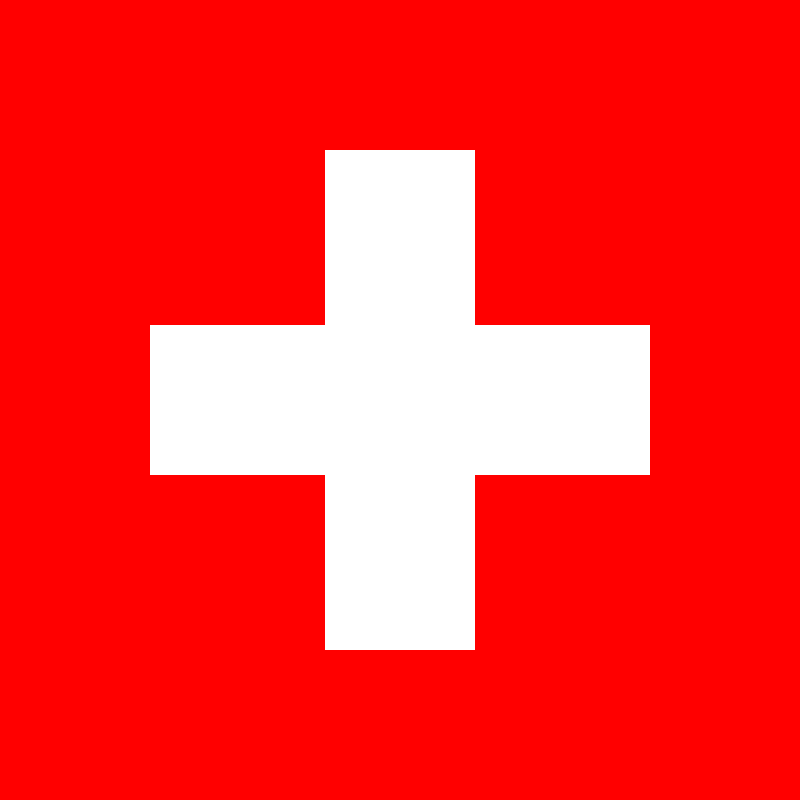1. Historical Evolution:
The evolution of the Switzerland flag is closely intertwined with the complex development of the Swiss Confederation. Through centuries of shifting alliances and collaborations, the cantons of Switzerland united to counter external threats and assert their sovereignty. The earliest recorded instance of the iconic white cross on a red background dates back to the late Middle Ages. This distinct emblem made appearances on seals, banners, and coats of arms of various Swiss cantons, symbolizing a potent blend of solidarity and unity amidst diversity.
2. Precise Proportions and Design:
The Switzerland flag, despite undergoing nuanced changes over its history, often conforms to a nearly square aspect ratio, approximately 1:1. At the heart of this design stands the white cross, meticulously positioned in the center of the red field. The cross's arms extend with mathematical precision to the edges of the flag, creating a harmonious and balanced visual effect. The width of the cross's arms, accounting for around one-seventh of the flag's vertical dimension, is a testament to the thoughtfulness and precision embedded within its construction.
3. Symbolism and Meanings:
The Switzerland flag encapsulates profound layers of symbolism that reflect the nation's values, history, and aspirations:
Unity Amidst Federalism: The white cross, stretching across the entirety of the flag, embodies the collective unity and collaborative spirit of the Swiss cantons. This unity coexists harmoniously with their individual autonomy, collectively forging the framework of a federal state. A Historical Odyssey: The flag's origin, rooted in the tale of Swiss soldiers sewing white crosses onto their attire, is a poignant representation of the nation's arduous journey for freedom, self-determination, and defiance against oppressive forces. Guardians of Neutrality and Peace: Synonymous with Switzerland's enduring policy of neutrality, the flag serves as an enduring emblem of the nation's unwavering commitment to cultivating peaceful coexistence and diplomacy within the global community.
4. Flag Variations:
The Switzerland flag takes on various forms to cater to specific contexts:
State Flag: The flag, as outlined previously, functions as the official state flag utilized by federal and cantonal authorities.
Civil Flag: In instances where the cantonal coats of arms are omitted, the civil flag elegantly displays the quintessential white cross on a red backdrop, retaining its distinctive and recognizable character.
Military Flag: Serving the Swiss military, the flag adopts a square format, bordered by white, encapsulating both the nation's military legacy and its enduring commitment to the principles upheld by the Swiss cross.
5. International Organizations:The Switzerland flag's iconic design has radiated beyond national borders, inspiring emblematic representations within esteemed international organizations:
The Red Cross Movement: The Switzerland flag's influence has been pivotal in giving rise to the universally recognized emblem of the Red Cross. This symbol, borne from the Swiss flag's design, acts as a beacon for the International Committee of the Red Cross (ICRC) and the International Federation of Red Cross and Red Crescent Societies (IFRC). A universal symbol of compassion and assistance, it stands as a bastion of hope for those affected by conflict and natural disasters worldwide. The Red Crescent: In nations where the visual representation of the cross may not align with cultural norms, the Red Crescent emblem mirrors the humanitarian ethos of the Red Cross, promoting the same principles of aid and relief.
6. Display and Etiquette:
The display of the Switzerland flag is governed by a code of respect and reverence:
Display at Prominent Sites: The flag finds its place of honor adorning public buildings, private residences, and vessels registered within the borders of Switzerland.
Flag Protocol: A hallmark of Swiss etiquette dictates that the flag should never touch the ground, emphasizing its symbolic weight and significance. It commands a demeanor of utmost respect and care.
Mourning and Reflection: During periods of mourning, the flag may be flown at half-staff, serving as a solemn tribute to those who have passed. Position of Prestige: In settings where multiple national flags are displayed, the Switzerland flag claims a position of prominence, often positioned on the observer's left, a testament to its esteemed status.
7. Cultural Celebrations:
The Switzerland flag is a vital component of the nation's cultural fabric, playing a central role in commemorations and celebrations:
Swiss National Day: Celebrated annually on August 1st, Swiss National Day pays homage to the founding of the Swiss Confederation in the year 1291. The flag, raised high and with pride, takes center stage during exuberant festivities and events, serving as a poignant reminder of the country's storied history and enduring values. In summation, the Switzerland flag's evolution, intricate symbolism, and profound cultural significance converge to establish it as an enduring emblem of unity, freedom, and neutrality—both a cherished national symbol and a beacon of hope on the international stage.
Last Updated on: August 01, 2023